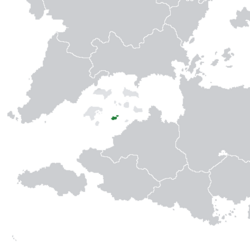Karukera Confederacy
Islands of Beautiful Waters Karukera | |||||||||
|---|---|---|---|---|---|---|---|---|---|
| 1388–1533 | |||||||||
 Location of Carucere | |||||||||
| Capital | None | ||||||||
| Common languages | Nati language Runanca | ||||||||
| Religion | Nati religion | ||||||||
| Government | Tribal confederation | ||||||||
| History | |||||||||
• Formation of the Confederacy | 1388 | ||||||||
| 1528 | |||||||||
• Conquest by Estmere | 1533 | ||||||||
| |||||||||
| Today part of | |||||||||
The Karukera Confederacy was a pre-colonial confederation of Nati chiefdoms on the islands of Carucere that existed from 1388 until its conquest by Estmerish Captain James Edwards in 1533. The confederacy had no official name; the name "Karukera Confederacy" was first used by academic papers in the 1960s. The native Nati used Karukera or the "The Island of Beautiful Waters" to refer to the land itself.
The Confederacy was formed in 1388 by Kasike Agüeybaná of the Aymanco chiefdom, after he convinced the other three tribal chiefs of Carucere to agree to a set of principles and agreements to conduct oceanic trade. The Confederacy was not a state in the traditional sense, but rather a strong network of alliances and agreements between the chiefdoms. The Aymanco chiefdom eventually grew to dominate the Confederacy through familial, matrimonial, and ceremonial ties that established a system of mutual obligations that encompassed the entire Confederacy.
While the society of the Confederacy remained largely agricultural, due to its geographic location in the Arucian and the massive natural harbor between Carucere's main islands, it was a central part of the trade network of the Medasteria. The Confederation grew prosperous from trading with Cutinsua and other chiefdoms on neighboring islands, bartering goods such as guayacán wood and pumice for food, metals, and other goods. Their trade, combined with efficient food gathering and agriculture, allowed the Confederacy to support a relatively high population density for the time period.
The confederacy initially attempted to cooperate with the first Euclean explorers in the 16th century, but after the destruction of Cutinsua and the collapse of Arucian oceanic trade, it was heavily weakened. The confederacy was destroyed in 1533 by an military expedition commanded by Captain James Edwards of Estmere, who established the Colony of St John on the island. Most of the native population were killed by the invasion and their numbers were further diminished by war, slavery, and famine. The remaining survivors were forced to flee into the interior of Marien, where they intermingled with run away slaves and formed the Carucerean Maroons.
The Confederacy continues to have major influence in contemporary Carucere, especially in the country's culture. Artifacts from the Confederacy continue to be discovered throughout Carucere; the country's museums display many Nati artifacts. Iconography purportedly used by the Confederacy are widely used in Carucerean culture; the most prominent example is the Aymanco crown used on Carucere's coat of arms. The Maroon community in Carucere is partially descended from the Nati population and some Nati traditions survive in Maroon culture and religious practices today.